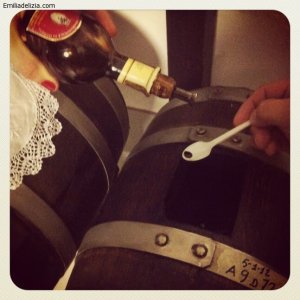There are really stringent laws governing what kind of cheese can be called Parmigiano Reggiano, so in fact the answer to the question should be: Only one kind – Parmesan cheeses produced in the regions which are covered by the Parmigiano Reggiano PDO (protected designation of origin). In reality, however, it is a little more complicated! Let me try to explain about the variations that can be found amongst cheeses that all proudly bear the PDO stamp which proclaims to the world that they are genuine Parmesan cheeses from the PDO region, which includes Parma, Reggio Emilia, Modena, Mantua and Bologna.
It may surprise you to know that there are about 420 creameries within this designated region, and these “parmesan factories” receive their milk from over four thousand farms every day. Inevitably, there will be a large variation in the end product from all these dairies, due to the season, altitude, breed of cattle and expertise of the cheese-maker. Another factor that hugely influences the final cheese is the period of maturation; the minimum time required for a cheese to fulfil the stringent appellation requirements is 12months, but some cheese wheels spend up to 36 months in the maturation cellars, during which time there is a very noticeable change in the taste and character of the cheese.
Factors which influence the final product are:
Maturation: at 12 months this medium-fat semi-hard cheese will have a pale cream colour, taste slightly salty, slightly acid and slightly sweet, and have a wonderful nutty fragrance – Parmigiano is never a smelly cheese! There is a slight grainy texture, one of the distinctive characteristics of this King of Cheeses. At 18 months, the texture has changed as more crystals develop and the straw colour of the cheese is a shade darker; the flavour is becoming more savoury and the fragrance has become a little fruity. The flavours and aroma of the cheese continue to deepen and mature, and the colour gets progressively darker. By 30+ months the cheese is fully mature, a golden straw colour with many crystals and can have woody, spicy, and dried-fruit flavours on your palate. The rind will be really hard at this stage.
Altitude: At higher altitudes, the dairy herd has access to sweeter, greener grass (Parmigiano herds are never fed anything other than grass!) and purer water, resulting in the cheese from the mountains (Parmigiano di Montagna) having a subtly deeper flavour. Many cheese connoisseurs also believe that cheeses made in Spring and Autumn are also superior due to the improved feed at these times of the year. Since each wheel is date-stamped, it is easy for cheese buyers to select cheeses made at these time of the year.
The Herd: if you are faming cattle for the meat market you choose good beef producing breeds, and likewise milk producers for the famous Parmigiano cheese production rely on superior milk-producing cows. In this region the most favoured breed is the Alpine Brown, bred exclusively in the mountainous areas. Recently “red cows” as they are locally known are making a coming back. The Rossa di Parma is native cow of the area and it produces a superior milk. These animals produce the very best balance of quality and quantity of milk – a really superior product just perfect for the production of a really superior cheese.
So, to get back to the original question – there is only one type of cheese that may be called Parmigiano Reggiano, produced in the areas covered by the PDO, but within the parameters set there can be fairly wide variations in the appearance, aroma and taste (and price!) of your slice of Parmigiano.

![IMG_2734[1]](https://i0.wp.com/www.emiliadelizia.com/wp-content/uploads/2013/01/IMG_27341-e1357380178784.jpg?resize=448%2C600&ssl=1)





















